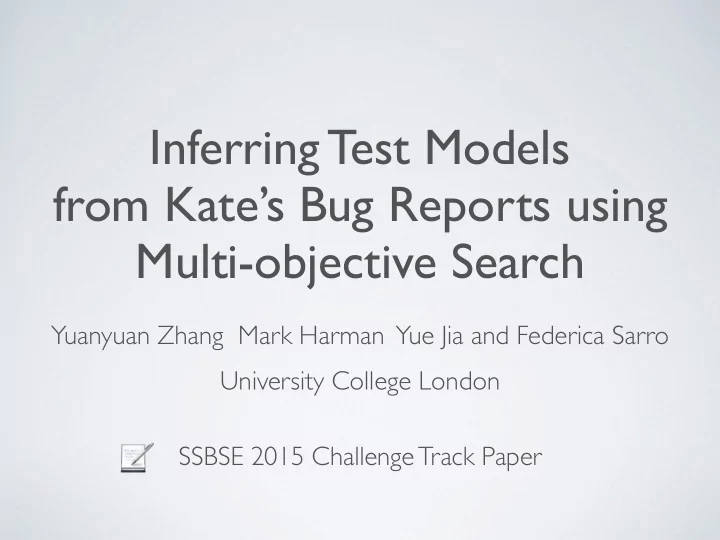

Inferring Test Models from Kate’s Bug Reports using Multi-objective Search Yuanyuan Zhang Mark Harman Yue Jia and Federica Sarro University College London SSBSE 2015 Challenge Track Paper
Which page should we put more effort to proofread?
Motivation Up to 24% of post-release bug fixes of large software systems are incorrect and even introduce additional faults
Event-based Model Inference Input: an abstraction of the observed sequences - log files (contain a sequence of execution traces function calls) <println, formatter, close, println> - bug reports (written in the natural language) Output: an inferred model - a FSM (accepts more traces than the observed ones and might not accept some of the observed traces)
Event-based Model Inference Challenges - bug reports (written in the natural language) A description of a bug Reproducible or not? Steps to Reproduce Actual Results Expected Results
Event-based Model Inference Challenges the generalisation capability of a model - a FSM (accepts more traces than the observed ones and might not accept some of the observed traces) introduce infeasible behaviours exclude possible behaviours over-approximation over-generalising under-approximation under-generalising
Model Inference Framework Seach-Based Extraction Parsing Data Mining Model Generation 1 2 3 4
Model Inference Framework 1. Filter Bug Reports Extraction filter terms: product; bug status; bug severity I1. Extract All Valid Bug Report IDs III. Crawl Bug Reports BUG 1 HTML HTML HTML REPORT
Model Inference Framework 1. Filter Bug Reports Parsing Description Reproducible Steps to Reproduce 2 Actual Results Expected Results
Model Inference Framework Parsing 1. Filter Bug Reports I1. OUTPUT .str Files HTML HTML HTML HTML HTML STR 2
Model Inference Framework 1. Preparing Training Corpus Data Mining pre-process transform All User VSM tf-idf Events Model Matrix project to n-dimensional latent semantic indexing space 3 Prepared Training Corpus
Model Inference Framework 1I. Clustering Similar User Events Data Mining similarity Prepared Each query cosine Training similarity User Similar Corpus Event Events Similarity Event 1 0.99 Event 2 0.75 similarity threshold Event 3 0.67 . . . 3 manual cluster & The Trace examine intersection Updated Events User Events
Model Inference Framework 1. Preparing Training Corpus Data Mining 1I. Clustering Similar User Events III. Mapping Trace Events HTML Trace HTML HTML HTML STR events 3
Model Inference Framework Multi-objective Fitness Functions Seach-Based Model Generation 1. Minimise over-approximation minimise the number of trace sequences generated from a model that do not correspond to any existing execution traces 2. Minimise under-approximation minimise the number of trace sequences that are excluded from a model 3. Minimise the number of states in a model Tonella, P., Marchetto, A., Nguyen, D.C., Jia, Y., Lakhotia, K., Harman, M.: Finding the Optimal Balance between Over and Under Approximation of Models Inferred from Execution Logs. In: Proceedings of IEEE 5th International Con- ference on Software Testing, Verification and Validation (ICST), Montreal, QC, Canada, IEEE (17-21 April 2012) 21–30
Experimental Setting Subject: Kate bug reports - KDE Bugtracking system 5583 bug issues reported since 2000 - 1/8 721 STR pattern Search algorithms: multi-objective GA, NSGA-II Benchmark tool: KLFA
Three Research Questions RQ0: What are the prevalence and the characteristics of the trace events generated? RQ1: What are the performance of multi-objective optimisation compared to the benchmark model inference technique, KLFA, in terms of the hypervolume, running time and the number of solutions? RQ2: What is the fault revealing ability of the models inferred?
RQ0 Example of Trace Events Generated 721 bug reports 452 user events files 265 unique trace events
RQ1 Performance of the Algorithms - Three Objectives
KLFA
KLFA
KLFA
S12 open_kate start_kate open_file install_kate change_keyboard_setting S4 S23 S34 S3 S10 ctrl set_encoding settings shift_enter highlight_line add_file open_kate S29 S16 S17 S30 S6 S36 S15 enter_text open_file enable_show_sidebar open_command_line move_cursor S31 S8 S13 S38 S21 find add_order_mark click_action run_script S5 S18 S2 S27 enter_text open_file click_button settings create_session S14 click_button S1 close_kate S22 enter_text open_file create_session S32 S33 S20 run_command alt_t_h enter_text open_file S9 S28 S25 S26 enter_text move_cursor set_sidebar_document_display S11 S19 S7 ctrl enter_text select_remote_file S35 S39 S24 copy S37
RQ1 Performance of the Algorithms - Quality Metrics
RQ2 Fault-Revealing Ability of the Model Divided 452 user events files into training and test sets based on submission time. Training set: 226 user events files from July 2009 to Oct. 2012 Test set: 226 user events files from Nov. 2012 to Feb. 2015 checking the number of trace events, which are in the test set, accepted by the models generated by the training set If a bug trace event is accepted by a model, the model can be used to generate test trace sequence to capture this bug
Inferring Test Models from Kate’s Bug Reports using Multi-objective Search
Recommend
More recommend